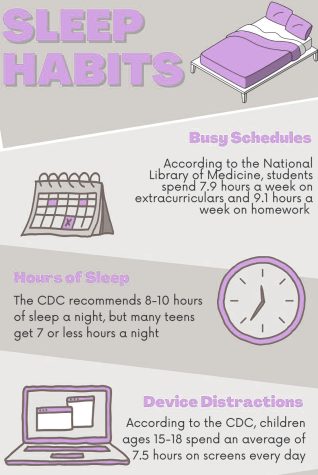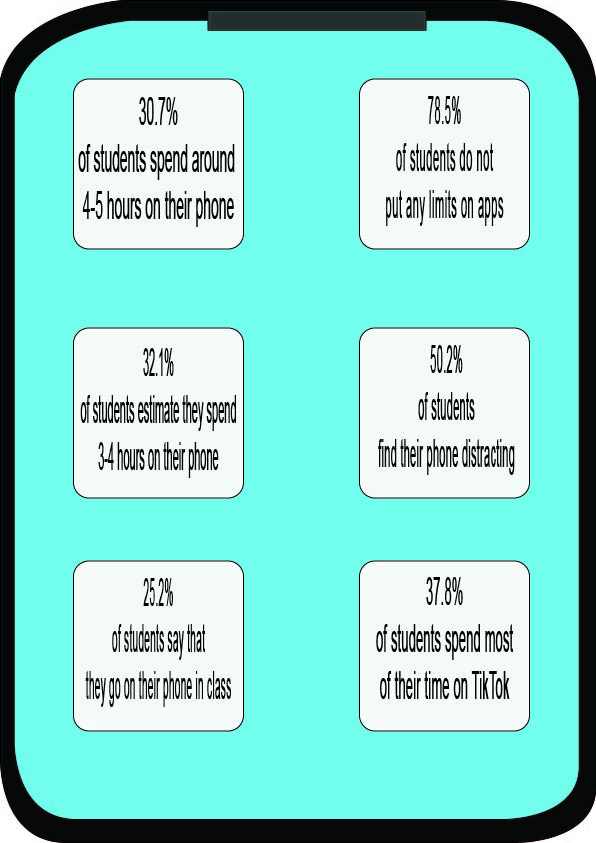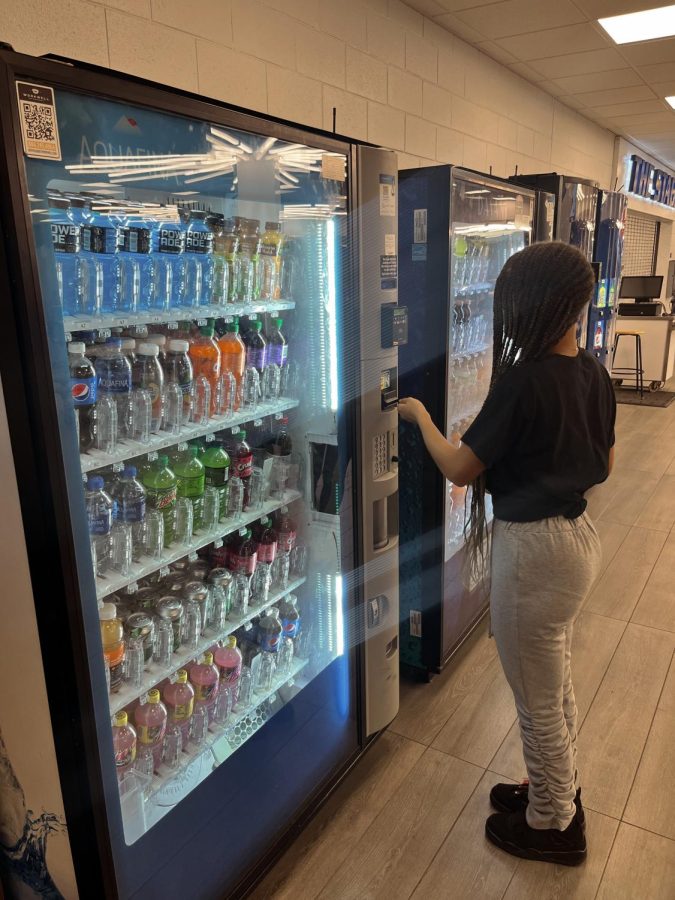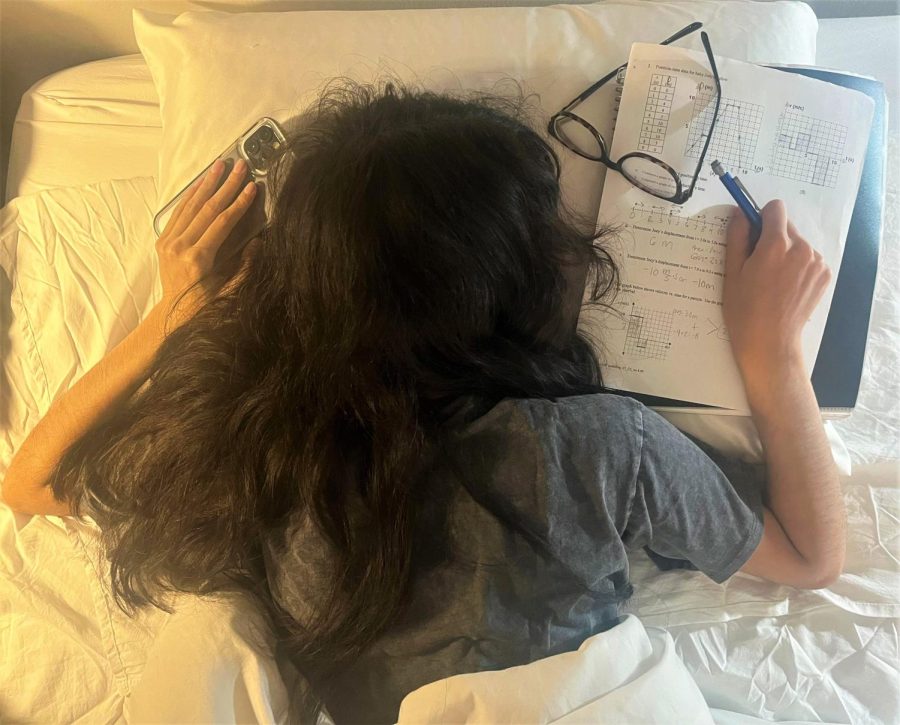Teenage Traps
October 31, 2022
Teens in a modern world face many stressors in their everyday life. When dealing with these issues, it can be easy to develop negative habits instead of coming up with healthy coping mechanisms. Here are the top bad habits that teens form, and how one can avoid them.
Teens stuck in the digital warp of screen time
The DGS Blueprint sent out an email surveying the student body; 234 people responded to collect the information presented above
The room is dark except for the small square of light reflecting in their eyes. It’s a school night, but rather than getting a good night’s sleep, this student is up past 2 a.m. scrolling through TikTok. They have no intention of going to bed soon.
This narrative could describe many high school students. A survey of 234 DGS students showed that 66.1% of high schoolers find themselves staying up to go on their phones. Additionally, 53.6% of high schoolers spend over four hours on their phones each day.
According to the American Heart Association (AHA), too much screen time leads to poor sleep, reading and social skills. The AHA states, “teenagers who spent more time watching TV, playing video games or on a computer were more likely as young adults to be obese and have…conditions that increase the risk for heart disease and stroke.”
On top of these physical effects, social media sites like TikTok have proven to affect students’ grade performance. The app depicts short, addicting videos, making it easy to spend hours scrolling through the clips.
When asked about social media, school counselor Kate Blader felt that there could be pros and cons.
“I think it’s about using it responsibly and knowing when it’s becoming too much, when you’re feeling a loss of control with it. I feel like the positives are connection and learning about others…I think you have to be careful with knowing what you’re seeing is not always reality and keeping that in mind while you’re on social media,” Blader said.
The balance between social media and real life can be difficult for teens to manage. It can help form bonds with others, but it can also be dangerous for teens’ mental health. Junior Drew Staser had something to say about the negatives of social media.
“I think it’s pretty bad for people’s mental health. It’s bad for my mental health, so I got rid of it a few years ago. I think there’s a quality in being able to connect with friends, but I don’t think there’s much quality outside of that – being able to connect with the rest of the world can be dangerous,” Staser said.
Setting app limits, especially on social media apps, can help with reducing screen time. Additionally, high schoolers can lower their screen time and increase productivity by putting their phone across the room while doing homework. Leaving one’s phone downstairs while sleeping will also prevent staying up late.
Spending habits affect teenage futures
Impulsive and unreasonable spending can sometimes stem from poor education on the subject.
Indulging in some guilty pleasures is something that the majority of people find themselves doing every so often. Engaging in these activities in moderation allows for a healthy and maintainable balance between treating yourself to something special, and completely over doing it. But where is that line, and why do so many teens seem to be on the other side of it?
Based on what is known about the education system, it can be concluded that teens are not fully responsible for not knowing where this line stands. Most teens claim that economics and how to hold a healthy relationship with money was never taught at an early age.
Economics teacher Motti Pikelny knows that there is a gap in knowledge surrounding the topic of money when it comes to many teens. He sees a need for the education system to step up and help relay this information earlier on.
“I have two kids, a nine-year-old and a six-year-old, and my nine-year-old is the epitome of impulsiveness with his spending. I think working with kids, especially when they are younger, can translate to people when they are in high school and being able to have an easier time making non impulsive financial decisions,” Pikelny said.
Senior Benjamin Paladino is currently employed at Starbucks and admits to having a hard time saving his paychecks when he could spend it on something he wants in the present.
“I have a job at Starbucks, and I can make fairly good money working there. I think since I am making an income, it leads me to being at times a little bit reckless with my money. Sometimes I can make irresponsible impulsive purchases that will make me happy in the moment. For example, I am in the process of trying to buy the Ariana Grande “Sweetener” album for $220,” Paladino said.
On the other side of the spectrum, teens who have jobs aren’t the only ones who have a need to spend money. Senior Yaremy Flores is currently unemployed, but somehow still finds a way to feed her desire to spend money.
“I have a really bad online shopping habit. Something about shopping online makes me feel like I am not actually spending any. I don’t currently have a job, so I am constantly broke and using all of the money that my parents loan me,” Flores said.
Based on reflection of the past, the trend of impulsivity for finances looks like it has no intention in baking off. Teens and humans in general are prone to looking at things in the short-term perspective, lacking to consider the future.
“It’s not easy for humans to weigh long term benefits over short term costs. It’s not always natural and a lot of times, students seek out short term pleasure or success that comes in the form of buying things or whatever it is that is right there available over the sort of long term satisfaction,” Pikelny said.
The present is tempting but saving for the future leaves for a roomful of opportunities. Conscious and logical decision making is key and knowing when it’s okay to have a little splurge to treat yourself is something that all teens must be able to decipher now and in the future.
Dangers of trendy energy drinks and coffee: Teens guilty of caffeine overload
While a daily coffee is part of many high school students’ routine, many studies show that caffeine addiction in teens is a rising issue that is not going away anytime soon. According to the American Academy of Pediatrics, the recommended maximum daily consumption of caffeine for teens is 100 mg.
Senior Mary Ghawaly is one of many high school students who regularly consumes over the recommended amount of caffeine.
“It depends on the day, but if I have time, I’ll usually wake up and have two cups [of coffee] so maybe 200 mg of caffeine, and then I’ll have a cup in the middle of the day. There have been days where I’m just constantly drinking coffee. Last year, I used to do 500 mg, maybe 600,” Ghawaly said.
In addition to just coffee, many teens are drinking energy drinks from brands such as Bang, Rockstar, Red Bull, Monster and Celsius. Energy drinks have seen a rise in popularity despite being linked to cardiovascular complications, insomnia, anxiety and dehydration among other side effects by the Center for Disease Control (CDC). The amount of caffeine in an energy drink can range from 80-250 mg per serving size.
Social studies teacher Derek Hoovel is a self-proclaimed caffeine lover but described how a daily school schedule can exacerbate exhaustion in teens, leading them to rely on caffeine.
“We start school at a time that really isn’t conducive to the teenage physiology because [teens] are geared to stay up late at night and sleep late in the morning, but we don’t allow you to do that, yet you still end up staying up late at night. You’re lacking sleep and [need] a little bit of an artificial boost to get you through some of those morning classes,” Hoovel said.
In addition to exhaustion from school, Hoovel added that coffee companies hook teens at a young age with their marketing and sugary drinks, which keep them coming back.
“Most teenagers aren’t getting the straight black cold brew… they go straight to a lot of the sweeter kinds. That gets them hooked on caffeine early. [It’s] smart marketing when you’re building up a clientele for decades to come,” Hoovel said.
Harmful sleep habits interfere with daily life
No matter the age everyone needs sleep to function. However, work, school, extracurricular activities and busy schedules can take up most of teens’ days, causing them to get less sleep.
Stress Management teacher Stephanie Henrikson describes how sleep helps every aspect of one’s general health, and that screen time is one of the main factors interfering with sleep.
“While school work is important and students are working hard, they need to know when it’s time to put distractions away and create a wind down for at least 30 minutes or so,” Henrikson said.
Henrikson states that according to the Center of Disease Control (CDC), teenagers should be getting eight to ten hours of sleep.
Sophomore Nathan Gudz tends to have a solid sleep schedule but struggles with his phone distracting him, which is the same problem Henrikson indicated earlier.
“I’m on my phone before I go to sleep, and then I usually sleep about maybe like seven hours. I feel like I could get some more [sleep] by staying off of my phone and go to bed a little earlier,” Gudz said.
Another reason why people aren’t receiving enough sleep is due to procrastination. Senior Josh Harap struggles with this habit and tends to do his homework late at night, affecting the hour he goes to bed. To improve his sleep schedule, Harap recognizes he needs to change his bedtime behaviors.

“I’ve been trying to be getting more sleep, and I’ve done that by getting to bed earlier because I’m not changing the time I wake up. So we’ll see if I could work around that schedule because I think sleep is really important for how you perform in school or life in general,” Harap said.
Junior Rory Saurez-Fuentes responds with how much longer their days are with school and work occurring within the same day; especially not being able to sleep in since school times are early.
“Both school and work on Fridays and Saturdays [takes up sleep]. I sleep for five to six hours on weekdays and eight to ten hours on weekends,” Saurez-Fuentes said.
Freshman Ethan Garrigues has a tight schedule with soccer. However, he has a firm belief that sleep is needed to function.
“I sleep for like eight hours; I do soccer after school until six. I get enough sleep,” Garrigues said.
Other students that do extracurriculars like clubs or sports may not have the same luck as Garrigues due to overcrowded schedules and a heavy workload in addition to extracurriculars.
Overall, many of the students interviewed seem to have different sleep schedules, whether it’s work, school, sports, procrastination or electronics getting in the way. Yet, take into consideration that sleep is important and maintaining a controlled sleep pattern will result into feeling best rested.





